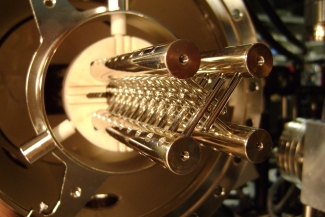Pulsed deceleration utilizes pairs of oppositely charged rods to create the longitudinal potential hill for cold polar molecules to climb. Before they can fall down the potential hill and regain their kinetic energy, the pin pairs are quickly discharged. This process is repeated with successive stages of electrodes until the molecules have been sufficiently slowed to be loaded into an electrostatic trap. Additionally, transverse guidance of the molecules is achieved because the molecules are attracted to the minimum of electric field along the center of the decelerator. Successive pin pairs are orientated orthogonally to one another, to guide the molecules equally in both transverse dimensions.
Current research involves the trapping of slowed hydroxyl radicals (OH) for cold collision studies with rubidium (Rb). For more information, visit our cold molecular collisions page.
In the past, we trapped slowed ammonia molecules (ND3) to study density fluctuations and trap loading dynamics. We used Monte Carlo simulations to optimize the trap loading timing. An example of loading the electric trap can be seen in the following phase-space and coordinate-space simulations:





